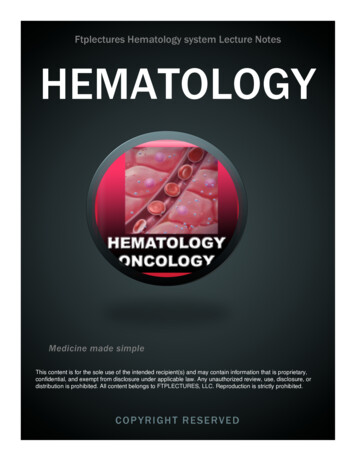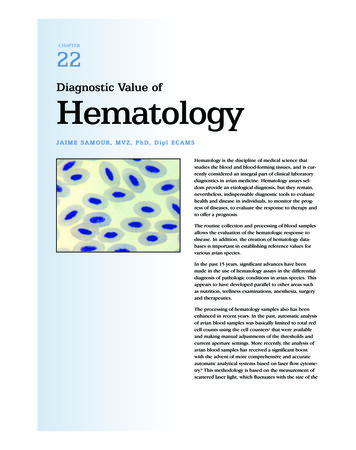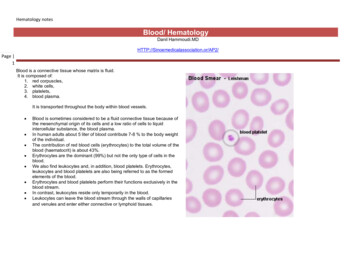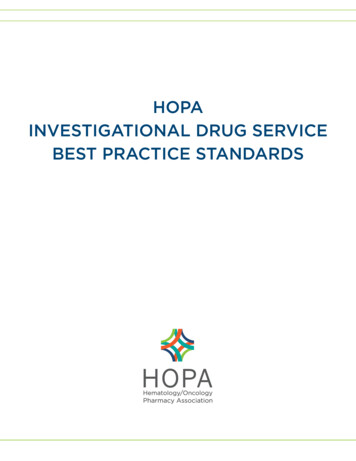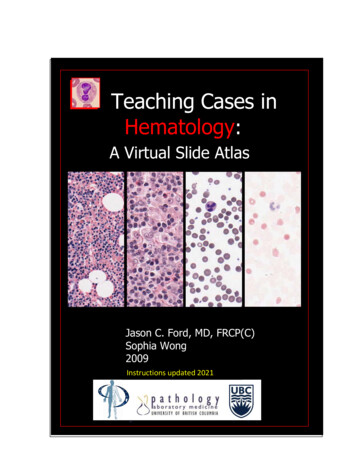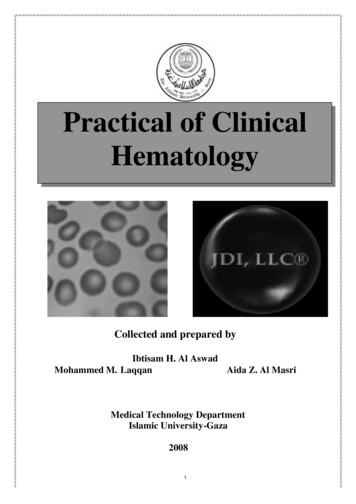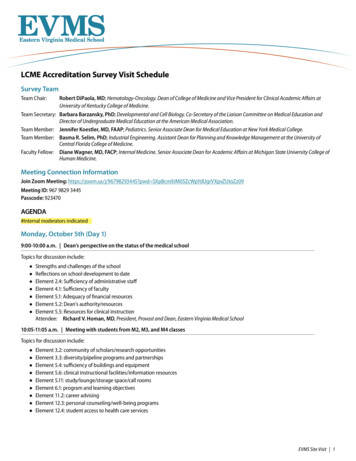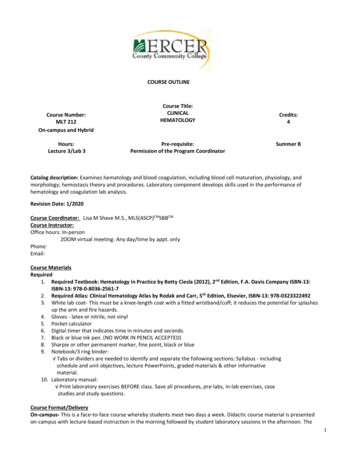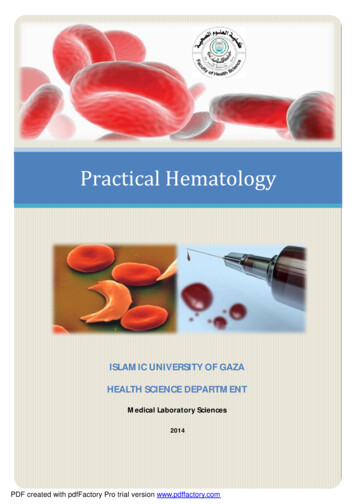
Transcription
Practical HematologyISLAMIC UNIVERSITY OF GAZAHEALTH SCIENCE DEPARTMENTMedical Laboratory Sciences20141PDF created with pdfFactory Pro trial version www.pdffactory.com
PRACTICAL HEMATOLOGYLAB NO.LAB Slide preparation and staining, The White Blood Cell Differential , andPlatelet estimation.Assessing Red Blood Cell Morphology.Reticulocyte counts, Alkaline & Acid Hemoglobin Electrophoresis.Detec on of sickle cell . Quiz 1Hemoglobin A2 Determina on, Quan fica on of fetal hemoglobin.Hemoglobin F Acid Stain, Screening test for G6PDH Deficiency.Quantification of methemoglobin, Blood Sucrose Test. Quiz 2Osmotic Fragility test.Automated Hematology Cell Counters.Normal Cell Maturation, Leukemia Classification.Leukemia Classification, Special stains.QUIZ 1& 210LAB RESULTS10SLIDE EXAM20MANUAL FINAL EXAM20FINAL PERSPECTIVE EXAM30ATTENDANCES102PDF created with pdfFactory Pro trial version www.pdffactory.com
ContentEvaluation of peripheral Blood smearABCSlide preparation and staining.The White Blood Cell Differential and Platelet estimation.Assessing Red Blood Cell Morphology.Methods used in detection and monitoring of anemiaAReticulocyte counts, Reticulocyte counts Using the Miller Disc.Standard Methods for specific anemia's.ABCDEFDetection of sickle cell.Alkaline Hemoglobin Electrophoresis.Acid Hemoglobin Electrophoresis.Hemoglobin A2 Determination .Hemoglobin F Acid Stain.Screening test for G6PDH De iciency.Methods to Detect RED Cell Membrane DisordersABBlood Sucrose Test.Osmotic Fragility test.Automated Hematology Cell Counters.Normal Cell Maturation.Leukemia Classification according Morphology & special stain.Special stains.3PDF created with pdfFactory Pro trial version www.pdffactory.com
A Peripheral blood smear preparationand stainingWhen automated differentials do not meet specified criteria programmed into theautomated hematologyinstrument, the technologist/technician must perform amanualdifferential count from a prepared smear.There are three types of blood smears:1. The cover glass smear.2. the wedge smear3. thespun smear.The wedge blood smear will be discussed in this lab. and It is the most common smearpreparation in the hematology laboratory and Wright stain, a Romanowsky stain, is the mostcommon dye.The are two additional types of blood smear used for specific purposes.1. The Buffy coat smear is for use on patient specimens when the patient's whiteblood cell count is less than 1.0 109/L and it is desirable to perform a 100-celldifferential. This procedure concentrates the nucleated cells present in the blood.2. Thick blood smears are commonly used when specifically looking for blood parasitessuch as malaria.Proper Preparation of a Peripheral Blood SmearObjectiveAt the completion of this laboratory, the student will be able to:1. State the appropriate sample used for preparing a peripheral blood smear.2. Describe the appearance of a well prepared blood smear.3. Demonstrate the appropriate technique for preparing a peripheral blood smear.4. Evaluate prepared blood smears for acceptability in the clinical laboratory.PrincipleThe wedge smear will be discussed in thisprocedure. Smears are prepared by placing a dropofblood on a clean glass slide and spreading the dropusing another glass slide at an angle.The slide is thenstained and observed microscopically.Specimen1. EDTA specimen2. Smears are made from EDTAa. EDTA blood within 2 to 3 hoursb. Check all Microtainers for clots with applicatorsticksRequirements for Proper Smear Preparation:1) Perfectly clean glass slides or coverslips2) Proper size blood drop3) Quick, smooth spreading of drop4) Rapid drying of smear5) Proper placement of drop6) Prepara on of smear within 3 hours of collec on4PDF created with pdfFactory Pro trial version www.pdffactory.com
Procedure:1. Mix sample well, either by inversion or by mechanical rocker. Remove stopperholding tube away from face. Using two wooden applicator sticks rim the tube andcheck for fibrin clots.2. Place a 1 X 3 inch slide on a flatsurface, place a 2-3 mm drop ofmixed whole blood about 1/4 inchfrom the right side of frosted area ofthe slide, utilizing the woodenapplicator sticks or filled a capillarytubethree-quarterfullwithanticoagulated specimen .3. Grasp a second slide (spreader slide)in the right hand between thumb andforefinger.4. Place the spreader slide onto thelower slide in front of the blood drop,and pull the slide back until it touchesthe drop.5. Allow the blood to spread by capillaryaction almost to the edges of the lower slide.6. Push the spreader slide forward at approximately a 30-40 angle, using a rapid, evenmotion. The weight of the spreader slide should be the only weight applied. DoNOT press down. Perform this step quickly. The drop of blood must be spreadwithin seconds or the cell distribution will be uneven. A thin film of blood in theshape of a bullet with a feathered edge will remain on the slide.7. Label the frosted edge with patient name, ID# and date.8. Allow the blood film to air-dry completely before staining. (Do not blow to dry. TheProcedure Notes1. Characteristics of a Good Smear1. Thick at one end, thinning out to a smooth rounded feather edge.2. Should occupy 2/3 of the total slide area.3. Should not touch any edge of the slide.4. Should be margin free, except for point of application.A well made, well distributed peripheral smearwill have a counting area at the thinpor on of thewedge smear which is approximately 200 red cells no ouching. A goodcounting area is an essential ingredientin a peripheral smear for evaluating the numbersofand types of white cells present and evaluating red celland platelet morphology.2. As soon as the drop of blood is placed on the glass slide, the smear should be made withoutdelay. Any delay results in an abnormal distribution of the white blood cells, with many ofthe large white cells accumulating at the thin edge of the smear.Rouleaux of the red bloodcells and platelet clumping may also occur.5PDF created with pdfFactory Pro trial version www.pdffactory.com
3. The thickness of the spread when pulling the smear is determined bya. Theangle of the spreader slide (the greater the angle, the thicker and shorter thesmear).b. Size of the blood drop.c. Speed of spreading.example1. If the hematocrit is increased, the angle of the spreader slide should be decreased.2. If the hematocrit is decreased, the angle of the spreader slide should be increased.4. Common causes of a poor blood smear:a. Drop of blood too large or too small.b. Spreader slide pushed across the slide in a jerky manner.c. Failure to keep the entire edge of the spreader slide against the slide while makingthe smear.d. Failure to keep the spreader slide at a 30 angle with the slide.e. Failure to push the spreader slide completely across the slide.f. Irregular spread with ridges and long tail: Edge of spreader dirty or chipped; dustyslideg. Holes in film: Slide contaminated with fat or greaseh. Cellular degenerative changes: delay in fixing, inadequate fixing time or methanolcontaminated with water.5. Although this is the easiest and most popular methods for producing a blood smear, it doesnot produce a quality smear. The WBCs are unevenly distributed and RBC distortion isseen at the edges. Smaller WBCs such as lymphocytes tend to reside in the middle of thefeathered edge. Large cells such as monocytes, immature cells and abnormal cells can befound in the outer limits of this area. Spun smears produce the most uniform distributionof blood cells.6. Biologic causes of a poor smeara. Cold agglutinin - RBCs will clump together. Warm the blood at 37 C for 5 minutes,and then remake the smear.b. Lipemia - holes will appear in the smear. There is nothing you can do to correct this.c. Rouleaux - RBC’s will form into stacks resembling coins. There is nothing you can doto correct this.6PDF created with pdfFactory Pro trial version www.pdffactory.com
Slide Staining With Romanowsky StainRomanowsky stainingRomanowsky stain are routinely used to stain peripheral blood and bone marrow smears.they are considered polychromatic stains in that the dyes present procedure multiple colorswhen applied on cells and cellular elements.PrincipleThe main components of a Romanowsky stain are:1. A cationic or basic dye (methylene blue or its oxidation products such as azure B*),which binds to anionic sites and gives a blue-grey color to nucleic acids (DNA orRNA), nucleoproteins, granules of basophils and weakly to granules of neutrophils2. An anionic or acidic dye such as eosin Y or eosin B, which binds to cationic sites onproteins and gives an orange-red color to hemoglobin and eosinophil granules.*Azure B ( trimethylthionin, a product of the oxidation of methylene blue) and eosin Y arethe most important components of the stain.The quantity of dyes used to prepare the stain are controlled in order to yield a neutralcompound . When the buffer solution is added to the stain, ionization occurs , during whichtime staining takes place. The eosin ions are negatively charged and stain the basiccomponents of the cells an orange to pink color. The acid structures of the cells are stainedvarying shades of blue to purple by the positively charged azure B. neutrophil granules areprobably stained by the azure compounds.The stains include in this category1. Wright's stain is composed of oxidized methylene blue and eosin azures. It is asimpler method .2. Giemsa stain is thought to produce more delicate staining characteristics. Itcombines eosin Y with azure B and methylene blue in methanol with glycerin addedas a stabilizer.3. Leishman's stain is similar to Wright's stain except for the method used to oxidizethe methylene blue. It is also a simple method, which is especially suitable when astained blood film is required urgently or the routine stain is not available (e.g. atnight).4. May-Gruwald is a good method for routine work.5. Field's stain is a rapid stain used primarily on thin films for malarial parasites.Fixation is important step, films must be fixed as soon as possible after they have dried todoes not allow any further change in the cells and makes them adhere to the Glass slide. It isimportant to prevent contact with water before fixation is complete. The presence of waterduring methanol fixation produces refractile body artifacts (water spots) in the erythrocytes.7PDF created with pdfFactory Pro trial version www.pdffactory.com
These water spots persist through staining of the smear and cover items of interest in thesmear. Further, they are distracting to the person evaluating the smear. In some cases, thewater spots may interfere with diagnosis.To prevent the alcohol from becoming contaminated by absorbed water, it must be stored ina bottle with a tightly fitting stopper and not left exposed to the atmosphere, especially inhumid climates.The preferred Alcohol is Methyl alcohol ( methanol), although ethyl alcohol ("absolutealcohol") can be used as fixative in Fixation.We use in this Lab leishmen's stain, It does not need to step fixation before staining, becausethe fixative present with the stain, but with the Wright, Giemsa satinare needed to it.LEISHMAN'S STAINPreparation of reagentsStaining SolutionPowder stain was weighed (0.2g) and transferred to a mortar. It was ground with about 25ml of methanol and allowed to settle. The supernatant was transferred through filter paperto a flask. Grinding was repeated with 25ml of alcohol each me un l all alcohol wasfinished and all powder was dissolved .The flask was placed in a water bath at 50 C for 15 minutes. It was then filtered in a cleanbrown bo le. Mixture was le for at least 2-3 days to mature. Required amount for daily usewas filtered into a smaller dropping bottle every morning.Buffer pH 6.8Stock buffer solution -A1. Anhydrous monobasic potassium phosphate( KH2PO4), 0.067 M.2. dissolve and dilute to 1L of dis lled water and stored at 40 C.9.1gStock buffer solution -B1. Anhydrous Dibasic potassium phosphate( K2HPO4), 0.067 M.9.4g2. Dissolve and dilute to 1L distilled water and stored at 4 C.Working buffer solu on PH 6.8 was made by mixing 50.8 ml of stock solution A with 49.2 mlof stock solution -B and dilu ng it up to 2 liters with dis lled water.REAGENTS OFFERED:1. Leishman's stain – Ready-To-Use2. Buffer-pH 6.8 phosphate buffer8PDF created with pdfFactory Pro trial version www.pdffactory.com
Staining Procedure1.2.3.4.5.6.7.8.Thin smear are air dried.Flood the smear with stain.Stain for 1-5 min. Experience will indicate the op mum me.Add an equal amount of buffer solution and mix the stain by blowing an eddy in thefluid.Leave the mixture on the slide for 10-15 min.Wash off by running water directly to the centre of the slide to prevent a residue ofprecipitated stain.Stand slide on end, and let dry in air.Staining characteristics of a correctly stained normal film: Nuclei Cytoplasm Erythrocytes Neutrophils Lymphocytes Monocytes Basophils Granules Neutrophils Eosinophils Basophils Monocytes PlateletsPurpleDeep pinkOrange-pinkBlue; some small lymphocytes deep blueGrey-blueBlueFine purpleRed-orangePurple-blackFine reddish (azurophil)PurpleCaution !!For using lieshmen's stainINHALATIONProlonged or repeated exposure may cause breathing difficulties and irritation.INGESTIONMay cause discomfort if swallowed.SKIN CONTACTProlonged or repeated exposure may cause irritation.EYE CONTACTProlonged contact may cause transient eye irritation.Discussion1. The phosphate buffer controls the pH of the stain. If the pH is too acid, those cells orcell parts taking up an acid dye stain will stain pinker and the acid components thatstain with the basic dye show very pale staining. If the stain-buffer mixture is tooalkaline, the red blood cells will appear grayish-blue and the white cell nuclei willstain very deeply purple. Therefore, to stain all cells and cell parts well, the pH of thephosphate buffer is critical .9PDF created with pdfFactory Pro trial version www.pdffactory.com
Causes & correctionToo Acid Stain:1) insufficient staining me2) prolonged buffering or washing3) old stainCorrection: 1) lengthen staining me2) check stain and buffer pH3) shorten buffering or wash meToo Alkaline Stain:1)2)3)4)thick blood smearprolonged staininginsufficient washingalkaline pH of stain componentsCorrection: 1) check pH2) shorten stain time3) prolong buffering me2. The staining rack must be exactly level to guard against uneven staining of thesmear .3. Insufficient washing of the smears when removing the stain and buffer mixture maycause stain precipitate on the dried smear .4. Excessive rinsing of the stained smear will cause the stain to fade .If it is desirable to restain a slide, the original stain may be removed with methanol. Floodthe smear with methanol and rinse with tap water as many times as necessary to removethe stain and then restain the slide according to the previously described procedure. Forbest results, however, make a new smear.10PDF created with pdfFactory Pro trial version www.pdffactory.com
Performing A Manual differentialAnd assessing RBC MorphologyIntroductionWhen blood samples are evaluated by the use of automated hematology analyzers, thisanalysis includes automated differentials. Specific criteria pertaining to normal, abnormal,and critical values have been programmed into the analyzers by the institution, and if thedifferentials do not meet these criteria, verification is necessary. This is done by performingmanual differentials and further evaluating the peripheral smear.objective1. To determine the relative number of each type of white cell present in the blood byperforming differential cell counts on five relatively normal blood smears and fivesets of abnormal blood smears within a 15% accuracy of the instructor's values.2. To determine within one qualitative unit the red cell, white cell, and plateletmorphology of each of the above blood smears.3. To determine within 20% accuracy an es mate of the white cell counts and theplatelet counts of each of the above blood smears.PrincipleFirst, a differential white blood cell (WBC) count is performed to determine the relativenumber of each type of white cell present. Technologists/technicians must recognize andproperly record the type(s) of white cell observed. Simultaneously, red cell, white cell, andplatelet morphology is noted and recorded. Also, a rough estimate of platelets and WBCcounts is made to determine if these numbers generally correlate with the automatedhematology analyzer. Technologists/technicians must be proficient at recognizing red andwhite cell abnormalities, identifying them correctly, and quantifying them.Reagents and equipment1. Manual cell counter designed for differential counts2. Microscope, immersion oil and lens paperSpecimenPeripheral blood smear made from EDTA-anticoagulated blood. Smears should be madewithin 1 hour of blood collec on from EDTA specimens stored at room temperature to avoiddistortion of cell morphology. Unstained smears can be stored for indefinite periods in a dryenvironment, but stained smears gradually fade unless cover slipped.11PDF created with pdfFactory Pro trial version www.pdffactory.com
ProcedureObservations Under 101. Place a well-stained slide on the stage of the microscope, smear side up, and focususing the low-power objective ( 10).2. Find an optimal area for the detailed examination of blood cells in which:a. Free of ragged edges and cell clumps.b. The RBCs are well separated from each other without touching each other.c. Avoid the areas containing large numbers of broken cells or precipitatedstain.3. Check the WBC distribution over the smear.4. Check that the slide is properly stained.5. Check for the presence of large platelets, platelet clumps, and fibrin strands.6. Check for the presence of any large abnormal cells (bone marrow cells).Observations Under 40 x-: WBC Estimates1. Place a drop of immersion oil on the slide and change the objective to 50 oil. (Incases where no 50 is available, use the 40 high dry with no oil.)2. Choose a portion of the peripheral smear where there is only slight overlapping ofthe RBCs. Count 10 fields, take the total number of white cells and divide by 10, andrefer to Table 1 to determine the WBC es mate.3. An alternative technique is to do a WBC estimate by taking the average number ofwhite cells and mul plying by 2000.Table 1WBC/HighPower Field2 to 44 to 66 to 1010 to 20 Estimated WBC CountFrom Peripheral SmearEstimated WBC Count4.0 to 7.0 109/L7.0 to 10.0 109/L10.0 to 13.0 109/L13.0 to 18.0 109/LObservations Under 100: Platelet Estimates1. Platelet estimates are done under 100 with the RBCs barely touching,approximately 200 RBCs. This takes place under the 100 objec ve (oil). On averagethere are 8 to 20 platelets per field. See Table 2.2. Ten fields are counted using the zigzag method. This method of counting is done bygoing back and forth lengthwise or sidewise (Fig.1).Figure1:Zigzag method of performingPlatelets per oil immersion field (OIF)differential. 8 platelets/OIF decreased8 to 20 platelets/OIF adequate 20 platelets/OIF increased12PDF created with pdfFactory Pro trial version www.pdffactory.com
3. A er the 10 fields are counted, the number of platelets is divided by 10 to get theaverage. The average number is now mul plied by a factor of 20,000 for wedgepreparations. For monolayer prepara ons, use a factor of 15,000.Table 2Average No.of Platelets per 100 Field0 to 11 to 45 to 810 to 1516 to 20 21 Platelet Estimate FromPeripheral SmearPlatelet Count Estimate 20,00020,000 to 80,000100,000 to 160,000200,000 to 300,000320,000 to 400,000 420,000Example: 120 platelets/10 fields 12 platelets per field12 20,000 240,000 plateletsManual Differential Counts1. These counts are done in the same area as WBC and platelet estimates with the redcells barely touching.2. This takes place under 100 (oil) using the zigzag method previously described inthe platelet es mate (see Fig.1).3. Count 100 WBCs including all cell lines from immature to mature. Normal values forWBCs can be found in Table 3. Reporting results§ Results are expressed as a percentage of the total leukocytes counted.§ It is also helpful to know the actual number of each white cell type per µL ofblood. This is referred to as the absolute count and is calculated as follows:Absolute number of cells/µl % of cell type in differential x white cell count§Reference values vary depending on age. For this exercise, the following valueswill be usedTable 3Cell TypeBirthTotal WBC x 103 10-26/µLNeutrophils %37-57Lymphocyte %25-35Monocyte %3-9Eosinophil %1-3Basophil %0-11 mo5-19.56 yr4.3-13.514 -150-6530-400-100-40-113PDF created with pdfFactory Pro trial version www.pdffactory.com
Observing and Recording Nucleated Red Blood Cells (nRBCs)1. If nRBCs are observed while performing the differential, they need to be reported.These elements in a peripheral smear are indicative of increased erythropoieticactivity and usually a pathologic condition. Additionally, the presence of nRBCs per100 white cells will falsely elevate the white count and is clinically significant.2. Correct the WBC count if the nRBC count is greater than 10 nRBCs/100. Thefollowing formula is applied for correcting NRBCs:WBC 100/NRBC 100Example : If WBC 5000 and 10 NRBCs have been countedThen 5,000 100/110 4545.50The corrected white count is 4545.50.Recording RBC Morphology1. Scan area using 100 (oil immersion).2. Observe 10 fields.3. Red cells are observed for size, color, hemoglobin content or pallor, and shape.4. Normal morphologya. Normocytic: normal cell size and shapeb. Normochromic: normal hemoglobin content and color5. Abnormal morphology: Red cell morphology is assessed according to size, shape,hemoglobin content, and the presence or absence of inclusions. See the followingsample grading system. Note that red cell morphology must be scanned in a goodcounting area. Two questions should be asked1. Is the morphology seen in every field?2. Is the morphology pathologic and not artificially induced?Table 4 & 5 represents a system derived to determine a quantitative scale.Table.4Qualitative Grading of RBC MorphologyGrade Degree of Abnormalities1 to 5 cells/10 fieldsSlight6 to 15 cells/10 fieldsModerate 15 cells/10 fieldsMarkedTable 5Grading InclusionsRare0 to 1/hpfFew1 to 2/hpfMod2 to 4 /hpfMany 5/hpfhpf, high-power field.14PDF created with pdfFactory Pro trial version www.pdffactory.com
Discussion1. A well-made and well-stained smear is essential to the accuracy of the differentialcount. The knowledge and ability of the cell morphologist is critical to high-qualityresults.2. When studying a stained smear, do not .progress too far into the thick area of theslide. The morphologic characteristics of the cells are difficult to distinguish in thisarea. Conversely, do not use the very thin portion of the smear where the red bloodcells appear completely filled with hemoglobin and show no area of central pallor.The cells in this area are generally distorted and do not show a true morphologicpicture .3. Before reporting significant abnormalities such as blasts, malaria or other significantfinding on a patient’s differential, ask a more experienced tech to review the smearfor confirmation. In clinical settings where a pathologist or hematologist is present,the smear is set aside for Pathologist Review.4. If disrupted cells are present such as smudge cells or basket cells, not them on thereport. It may be necessary to make an albumin smear to prevent the disruption ofthe cells. RBC morphology and WBC morphology must always be performed on thenon-albumin smear.5. When the WBC is very low (below 1,000/µL), it is difficult to find enough WBCs toperform a 100-cell differential. In this situation, a differential is usually performedby coun ng 50 cells. A nota on on the report must be made that only 50 white cellswere counted. Mul ply each percentage x 2.(Alterna vely, a buffy coat smear maybe prepared.)6. When the WBC is very high ( 50,000/µL), a 200-cell diff may be performed toincrease the accuracy of the diff. The results are then divided by 2 and a note madeon the report that 200 white cells were counted.7. Never hesitate to ask questions concerning morphology or the identification of cells.The differential is one of the most difficult laboratory tests to learn. In fact, learningabout cells and their morphology is a process that continues for as long as youperform differentials.Characteristics of blood cells Erythrocyte:Shape& size: Biconcave disc , size like lymphocyte nucleus.Nucleus : lost.Cytoplasm: pinkish hue, small area of central pallor.Number in man varies between 5 and 5.5 million per cubic mm of blood Platelet ( Thrompocytes)Nucleus: No nucleus.Cytoplasm: small amount bluish cytoplasm & contains reddish – purple granules.15PDF created with pdfFactory Pro trial version www.pdffactory.com
White blood cellsWhite blood cells, or leukocytes, are classified into two main groups; granulocytesand nongranulocytes (also known as agranulocytes).1. The granulocytes, which include neutrophils, eosinophils, and basophils,have granules in their cell cytoplasm. Neutrophils, eosinophils, and basophilsalso have a multilobed nucleus. As a result they are also calledpolymorphonuclear leukocytes or "polys." The nuclei of neutrophils alsoappear to be segmented, so they may also be called segmented neutrophilsor "segs."2. The nongranulocytes white blood cells, lymphocytes and monocytes, do nothave granules and have nonlobular nuclei. They are sometimes referred toas mononuclear leukocytes.Segmented NeutrophilsEosinophilBasophilSizetwice size of RBCs.slightly largerthan Eos.Nucleus2-5 lobes of nucleus (usually3), purplish-redLike neu. Or slightlylargerEccentric, usuallybilobed, rarely threeCytoplasmSPECIFICgranulesLight pink Primary &secondrygranule either pink orneutral fine, numerous,& evendistributedorange-pink orange-reddishorange uniformly round,large, evenlydistributed if poor stainedappear crystalloidnatureGenerally unsegmentedor clumped bilobed,rarely has 3-4 lobeslightly pink to colorless violet-blue( or purpleblack) large(obscure thenucleus) ,abundant,varying in size, Coarseand unevenlydistributed vary in number ,shapeand color, and lessnumerous thaneosinophil granules water-soluble andtend to wash outwhen stained (probably because ofimproper fixation).16PDF created with pdfFactory Pro trial version www.pdffactory.com
% from the Total 40% - 75 %WBCs countIncreasedin inflammation, and they actas the first line of defenseagainst invading pyogenicorganisms.granulesnonspecific : lysosomes ,synthesizeacid phosphatase,peroxidase, esterase,lysozyme.Specific: aminopeptidase,collagenase, lactofrrin,lysozyme.1%- 3%0.5 % - 1 %in allergic states and inparasitic infections.In inflammatoryprocesses , in immediate& delayedhypersensitivityheparin and histaminehighly metabolic andcontain histamine andother substancesLymphocyteMost lymphocyte are small, there are intermediate sizes and large lymphocytes.Small lymphocyte are usually round with smooth margins.Size: approximately the size of RBCCytoplasm: thin rim around nucleus, moderate to dark blueNucleus:round or oval in shape and may be slightly indented. No nucleoli are visible.MonocyteCytoplasm : Abundant. Blue-gray, outline may be irregular because of the presence ofpseudopods. Many fine azurophilic granules, giving a ground glass appearance.Vacuoles may sometimes be present.Nucleus: round, Kidney shaped, or may show slight lobulation. It may be folded over on topof itself, thus showing brainlike convolutions. No nucleoli are visible.§Leukocytosis, a WBC above 10,000, is usually due to an increase in one of the fivetypes of white blood cells and is given the name of the cell that shows the primaryincrease. Neutrophilic leukocytosisEosinophilic leukocytosisBasophilic leukocytosisLymphocytic leukocytosisMonocytic leukocytosis neutrophilia eosinophilia basophilia lymphocytosis monocytosis17PDF created with pdfFactory Pro trial version www.pdffactory.com
1. Neutrophils Neutrophils are so named because they are not well stained by either eosin, ared acidic stain, nor by methylene blue, a basic or alkaline stain. They are the body's primary defense against bacterial infection. Normally, mostof the neutrophils circulating in the bloodstream are in a mature form, with thenucleus of the cell being divided or segmented. The nucleus of less mature neutrophils is not segmented, but has a band or rodlike shape. Less mature neutrophils - those that have recently been releasedfrom the bone marrow into the bloodstream - are known as "bands" or "stabs".§Increased neutrophils count (neutrophilia) An increased need for neutrophils, as with an acute bacterial infection, willcause an increase in both the total number of mature neutrophils and the lessmature bands or stabs to respond to the infection. The term "shift to the left" isoften used when determining if a patient has an inflammatory process such asacute appendicitis or cholecystitis. In addition to bacterial infections, neutrophil counts are increased in:1.2.3.4.5.Many inflammatory processes.During physical stressWith tissue necrosis that might occur after a severe burnMyocardial infarction.Granulocytic leukemia. Shift to left ß Increased bands Means acute infection, usually bacterial.Shift to right à Increased hypersegmentedneutrophile.§Decreased neutrophil count (neutropenia)This take place in the following: Typhoid fever Brucelosis Viral diseases, including hepatitis, influenza, rubella, and mumps. An great infection can also deplete the bone marrow of neutrophilsand produce neutropenia. Many drugs used to treat cancer produce bone marrow depression andcan significantly lower the neutrophil count.2. LymphocytesLymphocytes are the prima
The wedge blood smear will be discussed in this lab. and It is the most common smear preparation in the hematology laboratory and Wright stain, a Romanowsky stain, is the most common dye. The are two additional types of blood smear used for specific purposes. 1. The Buffy coat smear
